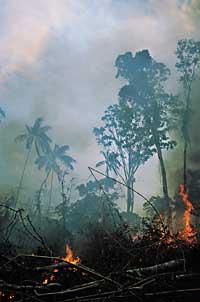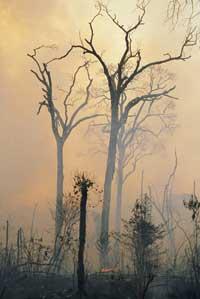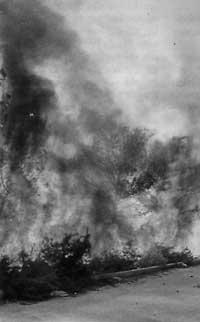Fires, cancellable or beneficial?
2002/01/27 Mendiburu, Joana - Elhuyar Zientziaren Komunikazioa
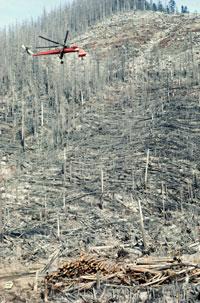
The very intense red flames grieve the fear and the burnt black areas. We believe that forests are going to go bankrupt and, in addition, assessments after fires suggest that assumptions are absolutely correct. However, the fire, although not so mentioned, also has its benefits, provided that it occurs in certain ecosystems and with a certain periodicity.
Fire initiation and extension
It is known that fires occur due to human negligence – poorly extinguished butts, unauthorized fires in camps, etc. – or by the great energy of lightning.
The expansion is conditioned by the force of the wind, the degree of humidity, the orography and the species that form the forest. The influence of wind and humidity is evident. The wind separates the margins, strengthens the fire and transports according to the orography. For example, the wind can drag the flames from top to top. In the plains, however, the fire spreads more linearly.
The plant species that make up the jungle also have to do with the extent of the fire. For example, a pine forest will burn much faster and easier than a oak tree. In fact, conifers — pines, sequoias, etc. — retain little water and, moreover, being resinous, burn like matches. On the contrary, leafy plants have much more water and, although dry, can contain enough water to cope with the fire. For example, between 38 and 43% of green oak leaves are water. What's more, in central Cameroon, thanks to the protection of the Chromolaena odorata plant, they have seen that the forest occupies more and more land. This plant was introduced in this region about thirty years ago and thanks to its numerous leaves, provides shade and fire protection to small plants.
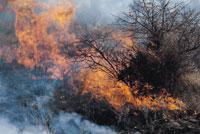
Finally, it should be noted that if the forest is composed of trees of great roots, the fire can be swept underground. The underground fire is not visible and, precisely, due to its difficulty of extinction can cause serious damage. In addition, many small animals are often hidden underground until the fire passes, so underground fire can be very dangerous.
Fire start new cycle
For the analysis of the consequences of the fire, one must take into account, on the one hand, the frequency of fires in the place and, on the other, the fauna and flora burned.
The consequence of a fire intentionally provoked in one place each year is very different from that caused by an intentional fire of management or produced by lightning. Fire does not change, but the burned ecosystem is not the same. If you eat each year, nature does not leave enough time to regenerate, so gradually it will become impoverished both the soil and the ecosystem.
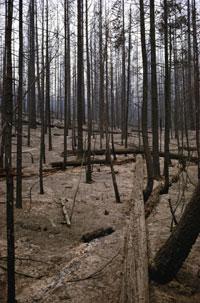
On the contrary, managers of unique ecosystems occasionally set fire to some areas in order to create new vegetation and, if the fire is well mastered, has been beneficial to the ecosystem. According to a report by the FAO (Food and Agriculture Organization of the United Nations), fire has been for many years one of the main agents of deforestation, so it was about turning it off as soon as possible. However, it has been proven that fire also plays an important role in the health of ecosystems and that there are currently areas where an intentional fire occurs. However, we must keep on realizing that not all plants respond in the same way to fire and therefore the influence of fire is very different from forest to forest.
The benefits of fire, in two words
As mentioned in previous lines, some plants have a low degree of moisture so they are easier to catch by fire. But nature does not do things halfway and has provided these plants with special fire fighting mechanisms. The fire only burns the skin of some of these plants, which makes the plant remain in the fire. Other plants, for their part, throw the seed as soon as the fire is detected so that the species remains. Although the fire is very intense, the seed does not burn and so, two years later, with total naturalness, the new plants replace the old ones.

In conifers there are also curious cases, such as Pinus banksiana. Fire for this type of pine, besides beneficial, is an indispensable element for reproduction. The seeds of this pine, like the rest of the pines, are found in the pineapple. What happens is that to open the pineapples and drop the seed to the ground is essential a very high temperature. Surprisingly, this temperature can only be achieved with fires.
But in addition to plants, birds of prey know how to make good use of fires. These birds, just after the fire, explore the burned corners to find animals like snakes, rabbits and the like that have died but are not calcined. Thus, without any difficulty, they earn copious meals.
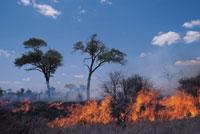
Also noteworthy is the case of the Melanophila beetles. In the world there are a dozen species of Melanophila beetles that are thrown into the fire to copulate and lay eggs. Fire is an untenable force of attraction for beetles approaching from afar. Healthy trees are plagued with defenses against the phytophagous larvae of beetles, fed with plant substances, and living by the neck of healthy pines is hard. Therefore, insects that feed on wood generally prefer diseased or suffering trees, with their defenses reduced. And, optionally, the newly dead trees are very appropriate. It has also been said that they are able to travel 80 kilometers to reach the fire. The females arrive grouped to copulate in the ‘sweetness’ of the fire and, as the fire calms, lay the eggs under the surface of calcined trees.
It is clear, therefore, that although moderate fires can be very harmful, after the fire many things change, but life does not stop. However, knowing that fires can have a positive side is not the reason to start burning.
Millions of hectares of forests burned each yearMillions of hectares of forest are burned each year, and although in the previous lines we have underlined the benefits of fires, it is not necessary to rule out both economic and human damage caused by fires. In this sense, it is advisable to work in the field of prevention to minimize damage. Here are Greenpeace's ten recommendations for solving the forest fire problem:
|
Published in the supplement Natura de Gara.

Gai honi buruzko eduki gehiago
Elhuyarrek garatutako teknologia




